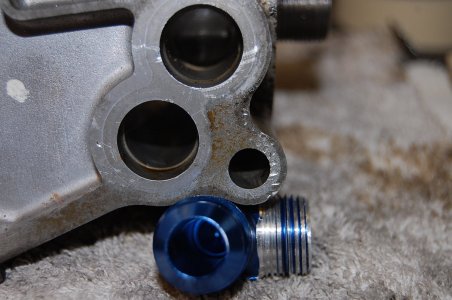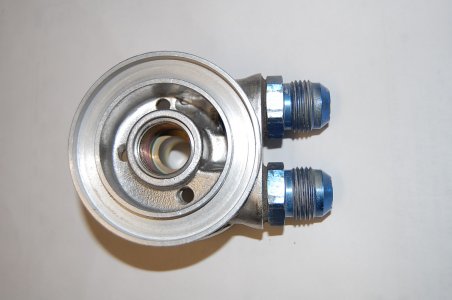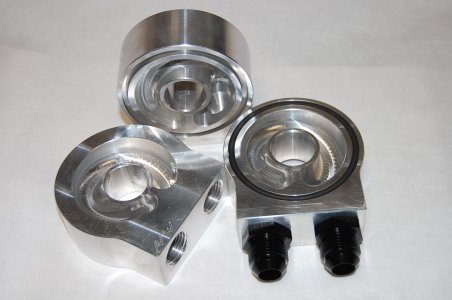Most cold-start procedures rev that high and adjust the timing to quickly heat the cats for emissions. 2,500rpm isn't "high" or an issue, and actually isn't a bad RPM to help warm the car up and build heat quicker. What I meant by "excessive" are those people who take a dead cold motor and then redline it to impress their friends. Also going full throttle isn't good on a cold motor. Redlining and going full throttle putting a lot of load on your car, shortly after starting it, even in 50*F weather is really not good (not saying that you do that), but oil is quite a bit thicker even at 100*F than it is at the measured 212*F "operating temperature" as used industry-wide to measure oil viscosity in Cst.
How much power did you make on the Ti rods? They have been known to fail around 450-500whp.
According to chemical engineers at a few different major oil companies, synthetic oil and its additives do start to break down at 300*F. Their flashpoints are usually around 375-475*F. Here's a pretty old test:
http://www.speedtalk.com/forum/viewtopic.php?f=1&t=31363
Here are the approximate observed temperatures at which the various oils started to vaporize/smoke, which indicated the onset of thermal breakdown:
5W30 Pennzoil Ultra, API SM = 280*
5W30 Mobil 1, API SN = 265*
10W30 Lucas Racing Only = 290*
5W50 Motorcraft, API SN = 275*
10W30 Amsoil Z-Rod Oil = 300*, the BEST in this test
20W50 Castrol GTX, API SN = 275*
5W20 Castrol Edge w/Titanium, API SN = 280*
10W30 Joe Gibbs XP3 NASCAR Racing Oil = 280*
5W30 Castrol GTX, API SN = 280*
10W30 Valvoline VR1 Racing Oil, silver bottle = 260*, the WORST in this test
0W30 Brad Penn, Penn Grade 1 = 280*
5W30 Royal Purple XPR = 285*
Here are the “averages” for the onset of thermal breakdown with these 12 oils:
Full synthetic oils = 282*
Semi-synthetic oil = 280*
Conventional dino oils = 272*
NASCAR engines are quite impressive. Making over 160hp/L from pushrod (and until recently, carburated) V8s. They often race for hours with oil temps above 300*F, but the engine is specifically built for this and rebuilt after every race. Plus they consume GALLONS of oil during a race. By the end of the race, the oil's shear strength is way down and the oil has broken down quite a lot. They run at this high of an oil temp for aerodynamic purposes, with as small of an opening as possible for the least drag and most downforce possible. It's really not a good idea to run a modern synthetic at this temperature. I've had 6-hour races where I ran Mobil-1 in a S54 BMW I-6 at 300*F for the entire race and the oil was toast by the end of the race. Also those engines were also rebuilt frequently. The engine did last, and would probably be fine for many more track days to come, but the oil did break down with more wear on the engine than what one would consider 'acceptable'.
Due to the NSX's very small oil pan, it really doesn't need or will benefit from an overly complex baffle design. If you increase the capacity (which is another very important thing for high demand uses -tracked cars, turboed cars, turboed track cars), then you do need something more complex than the typical top plate. Top plates are quite effective at preventing oil from sloshing up on the 'shelf' of the left side of the oil pan during long right-hand corners. Unfortunately most of them are not seam-welded and often have a gap where the plate meets this 'shelf' -thus greatly reducing the effectiveness of keeping oil in the deep sump in right hand corners. Ideally, you want the top plate to be flush against and seam-welded to the 'shelf'. While most baffles aren't ideal in this regard, all of them do a great job at allowing oil to drain back into the sump, so I disagree with your comments of 'restricting reflood'.
I agree baffled oil pans should be added to my list of stresses on the oil system, however from a cooling standpoint they are not exactly related, in that: you can starve the sump of oil with a good driver on sticky tires in an NA car on a cold day with ideal oil temperatures -and spin a rod bearing without a baffle, but you can also overheat, breakdown, and thin-out the oil on a turbocharged car at the track with a bad driver on street tires who doesn't push it in the corners to never have a oil starvation problem, but the oil can cause problems on a hot day with inadequate oil cooling. Now put them together, a good driver on sticky tires, with a turbocharged car, on a hot day with inadequate oil cooling and no baffle, and that's a recipe for disaster. I can't count the amount of blown NSX motors due to one or many of these factors (as well as tuning and bad luck) but it's probably over 15. I don't take oiling, turbocharging, or cooling lightly.
I think in general, you and I agree. My recommendation specifically for the OP, knowing his engine luck so far and the SOS prone-to-rupturing oil lines he's using, is to skip it for this rebuild and see how high his temps get on the track. I think I've said it enough here already, so I'll be quiet now. :smile:
I'd agree to that. I also don't take oil lines lightly, however I must say that i'm not aware of SOS oil line issues or the OP's engine troubles. If there's a problem with the lines, I'd recommend reaching out to and calling
www.bmrs.net and telling them the fitting size and hose length of his current lines and replace them with the aircraft-grade, lightweight crimped lines. BMRS is what the majority of NASCAR, Prototype, and Formula car teams use. They aren't cheap, but I wouldn't skimp on anything in the oil system of a car, especially high pressure lines feeding the bearings.











